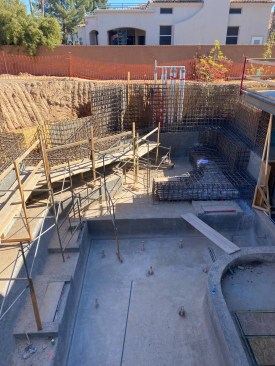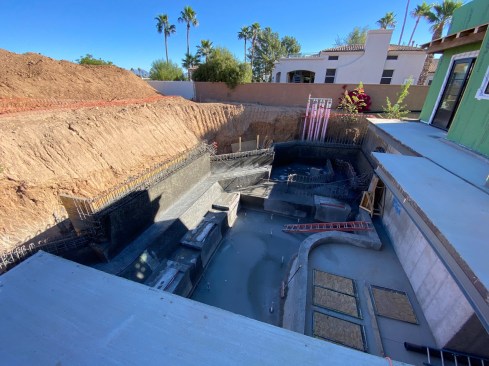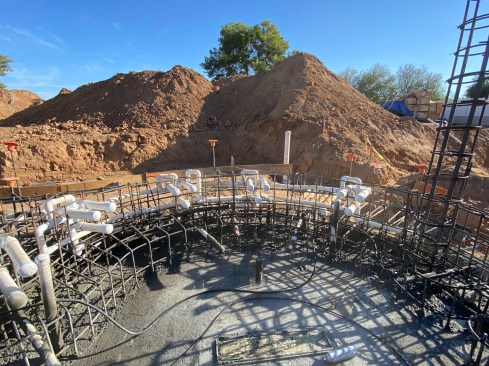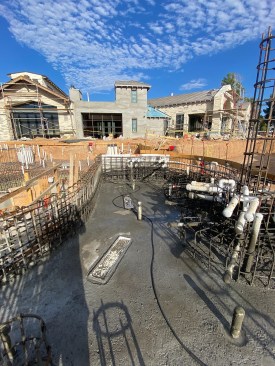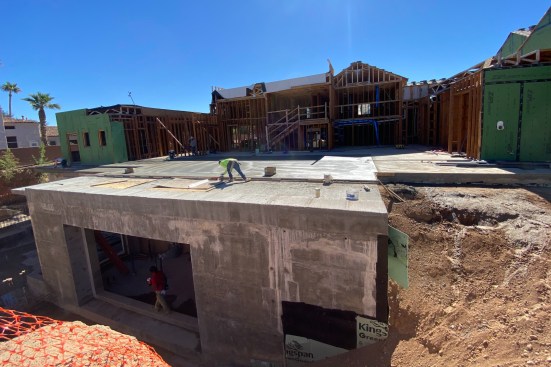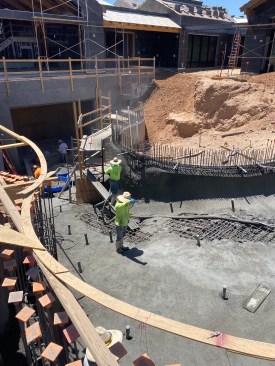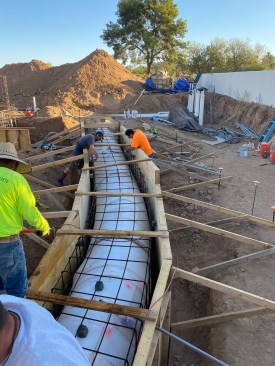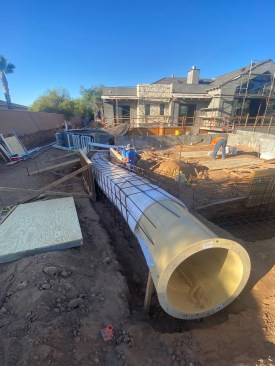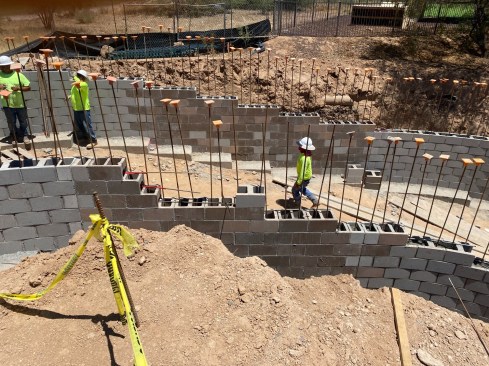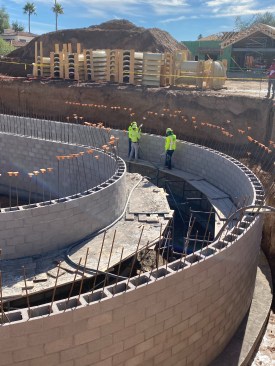This project, which we started nearly two years ago, is taking shape nicely.
All is going as planned. Some of the major elements in the backyard are nearly complete, while others are just starting. But for all the pieces of this intricate puzzle, ramped-up precision, supervision and collaboration have been required.
Getting materials and products can still be a challenge, but subcontractors have a little more flexibility and breathing room than they did toward the beginning, making coordination easier. We’re starting to see plumbers, excavators and steel companies have a little more time. The finish applicators are still very busy.
And throughout the project we continue to refine and add to the design, because of its size and complexity. So far, we have spent 1,375 hours just on the design of this backyard.
We’re projecting that, toward the end of the year, we’ll be ready to apply interior finishes and fill the pools.
Needless to say, we’re glad we work on a cost-plus basis! With the cost of labor and materials continuing to rise, this type of contract was essential for a project of this scope and fluidity.
Main and Basement Pools
Red Rock Pools & Spas
From the back of the main pool, a waterwall spills down to a basement pool that sits just outside the shark tank room. That weir wall and basement pool are completely shotcreted, as well as about 75% of the ground-level pool structures — the main pool, grotto area and swim-up bar area. These latter parts have the steel in place, and we’re now starting to connect that into the beginning of the river and surf simulator, which we’ve just excavated.
To do this, we’ve had to bring shotcrete crews on site 12 times so far, and they’ll come back probably another 10 more times. We’ve had a shotcrete crew scheduled every seven to 10 days to keep up with the construction schedule. We do this for several reasons. We can shoot 30 to 65 yards a day, depending on the complexity of the area. With supply-chain issues, we can’t always receive all the concrete we need at once — we may want 70 to 80 yards, but only have access to 40. So we split shoots into two days. After they shoot a section, we prepare for the next area — meaning excavation, steel, electrical and plumbing.
Red Rock Pools & Spas
Plus, we can only shoot 5 to 6 feet of height at a time, so the 17-foot deep end required a few days. We’d shoot 5 to 6 feet, set up scaffolding for the next phase, then shoot another few feet. Sometimes we’re dealing with really intricate areas that have a lot of radius walls, floating steps and benches. No matter how many guys we throw out at those times, we can’t get enough mud on the walls, do all the cutting and get all the shooting done in a single session.
Red Rock Pools & Spas
With all the different elevations and intricate work involved, these crews have had to perform a good portion of their work on scaffolding, and it’s involved plenty of form work as well, because a number of areas required over excavating. So it’s a different animal.
Slide
We have a majority of the tube slide system installed now, which required a number of culverts. In order to bury the fiberglass tube slide, we cast a culvert around it. We reinforced it in cast concrete around the majority of the slide before we buried it. In the rock waterfall area, in order to protect the slide, masonry walls with a concrete lid bears the weight, so we don’t have to place any weight on the fiberglass tube itself, which is not structural.
Red Rock Pools & Spas
The slide is about 140 feet long, so of course it starts in one location and ends up quite a ways from the entry point, and in a different elevation. This required a lot of preplanning, surveying and double checking dimensions to make sure we end up where we’re supposed to be.
Go-Kart Track Tunnel
We had done about 60% of the tunnel early in the project, based on site access and available room to work. We buried all those areas completely back up to grade. Recently we began excavation for the second quarter of the tunnel. We’ll go through the same process — we over-excavate for safety, establish our footings, put our masonry walls in place and then waterproof the outside of the walls. Then we pour the kart track in between the walls, and bring in an aluminum shoring system so we can cap the top of it, and pour concrete on top of that, then waterproof over the top of it as well.
Red Rock Pools & Spas
We use the shoring system, basically a large scaffolding system with adjustable legs, feet and cross braces, so we can then install a plywood decking system that will support the concrete structure that we pour on top of the track.
Three sections of the track sit beneath the lazy river. In these areas, the river and tunnel follow each other. Some sections of the tunnel will have acrylic windows on the ceiling, from the river above. You will be able to see into the cart tunnel from above, into the river from below, and the windows add light to the tunnel. Those are all getting blocked out currently. When the tunnel is finished, we will completely backfill it to full grade.
We’re also beginning to work on the two elements that intersect with the tunnel — the river and the surf simulator. Excavation has to be done carefully in these spots, so we don’t compromise the tunnel or compaction above it.
The sections where the tunnel and lazy river intersect will have 12 inches of concrete each for the river shell and the kart-path roof. This means we’ll have 24 inches of concrete anywhere the pool or river cross over the tunnel.
Because soil conditions are relatively good, we can support the tunnel walls with large spread footings, which are similar to large retaining walls, except once we cap them out, they are braced at the bottom and top. We went with a foundation that was a bit larger than we needed, just so we could backfill sooner, before we had the roof on it. Besides speed of construction, it affords some safety: If we can backfill most of those walls before building the platform on top of them, then we’re not working near a 6-, 8-, 10-, or 12-foot down. We can backfill to the top of the wall so they’re working closer to ground level when casting that roof and placing the concrete.
So far, we’re working in multiple areas that aren’t connected yet, so we’re collaborating closely with surveyors and engineers to pinpoint all our locations and elevations so that, when we start connecting the sections together, we’re in the right place and the right elevation.
Surf simulator
Clearly, this is not like any backyard pool. But perhaps the most unique feature for a residential setting is the inflatable surf simulator, with a transversing deck that conceals it when not in use.
We’re in the very early stages of construction, with only excavation completed at this point. But we are still, after all these months, finalizing all the minor details. The surf system sits inside a concrete shell that’s attached to the river system. Then the transversing deck runs over the top and ties in. Joining these systems entails plenty of intricate detail and very close tolerances.
My company and the maker of the surf simulator and the transversing floor continue to exchange information to fine-tune the design. We have a shared 3D model where Whitewater West puts its FlowRider, and then we send the entire system to Twinscape, the designer of the moving deck, which then adds its portion to the model. In doing this, we found a number of conflicts. We had to raise the deck almost 6 inches to make sure we didn’t have conflicts with it trying to close over the top of the simulator once it was deflated. We also found that Whitewater needed more access for their equipment, so we had to make a much bigger vault underneath that transversing deck.
So the process has been a three-tiered effect with all three companies to make sure we don’t end up with too many problems as we start assembling the parts. The simulator comes from the U.S., but the deck comes out of Europe, and we’re constructing in Paradise Valley, Ariz. So everything needs to fit perfectly.
The Big Picture
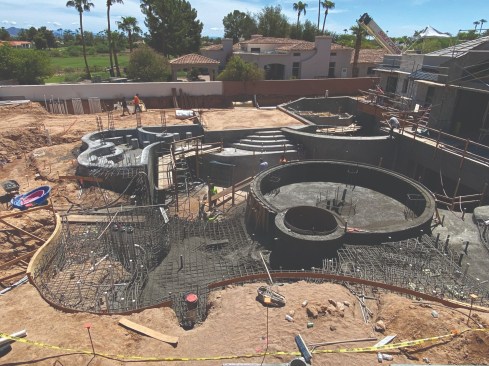
One of the most important lessons we’ve learned from this project is that something so extensive requires a nearly insurmountable amount of supervision and coordination. We thought we had overplanned in this regard by factoring in one supervisor to be on the site full time. We now have three supervisors on the project nearly full-time.
Elevations are critical. All these complex structures interconnect but are sprawled across such a large property. Yet the elevations must be perfect. On the surf simulator, the tolerance is less than 1 inch. Nobody’s afraid to make a decision on their own, but sometimes it takes a team to make sure that we’re in the right direction.
We have one guy managing the project. Then another is extremely technical and very good with field measurements, layouts and elevations, so he manages and watches most of that, as well as the formwork and framing. Then our formwork and framing crew leader is always managing dimensions and takeoffs and double checking everybody’s work.
It takes all three of them to cross check and reference. Yet, we still frequently have to make more adjustments to the plans to insure we have the dimensions we’re missing in one location, or information that wasn’t figured out yet in another. So we still spend about four to five hours a week in the design and plan set to update, modify or add more information for the field crews.


